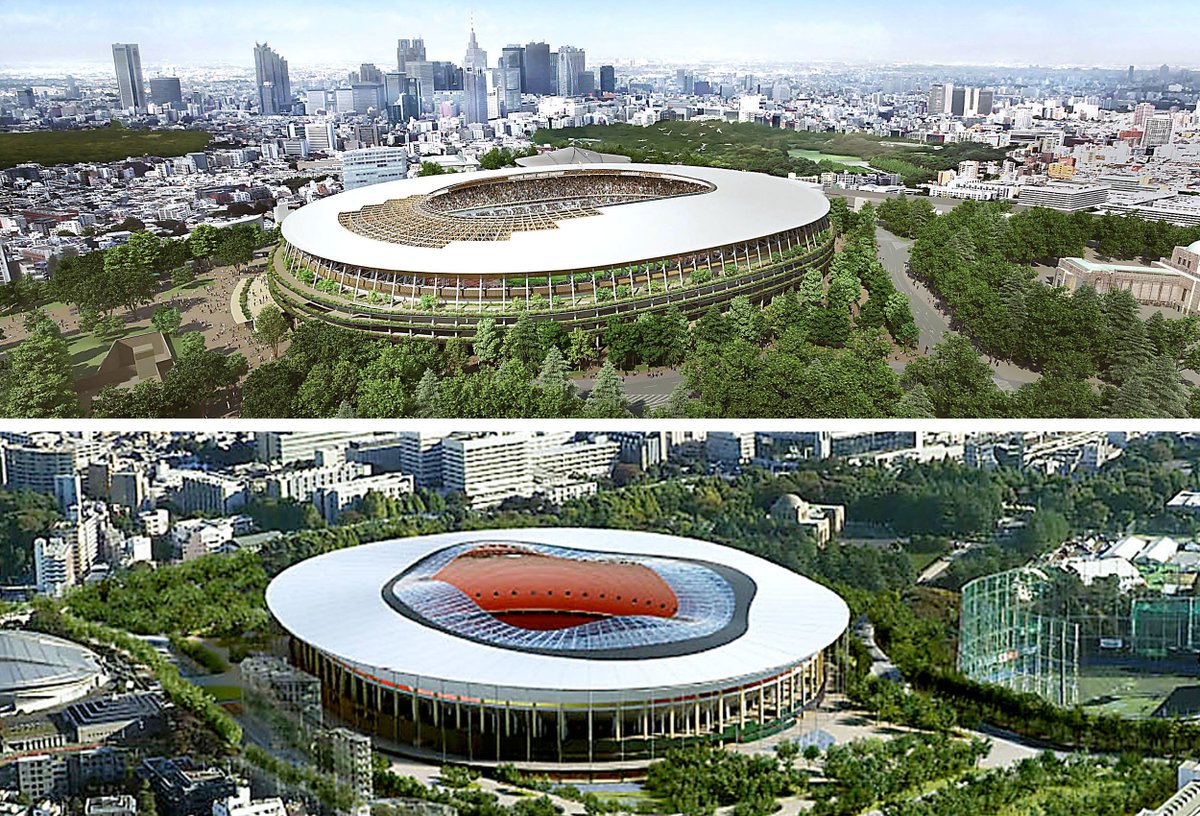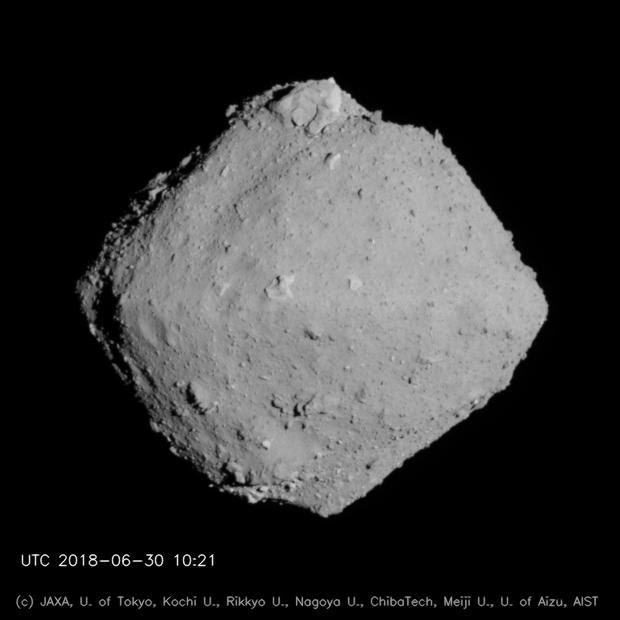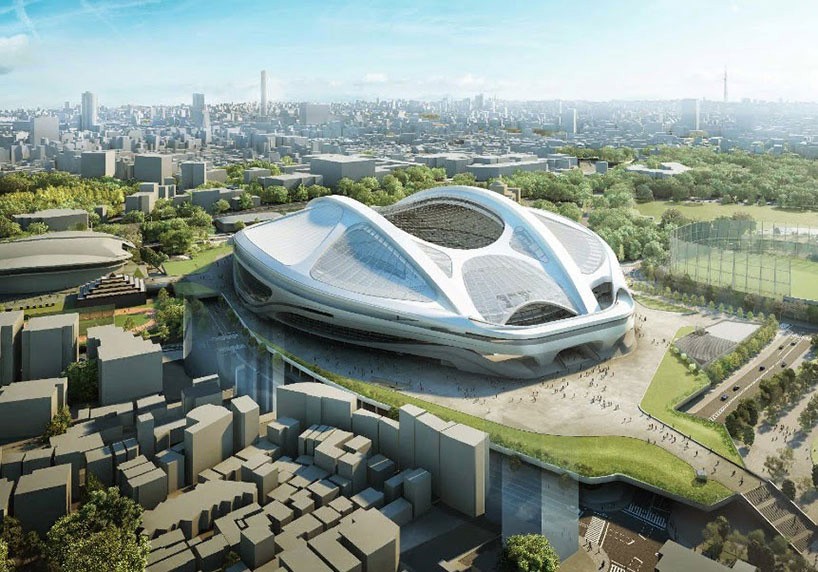
https://www.cnn.com/style/article/japan-olympics-stadium-design/index.html
 An artist’s rendition of the new Katase-Enoshima Station in Fujisawa, Kanagawa Prefecture (Provided by Odakyu Electric Railway Co.)
An artist’s rendition of the new Katase-Enoshima Station in Fujisawa, Kanagawa Prefecture (Provided by Odakyu Electric Railway Co.)
http://www.asahi.com/ajw/articles/AJ201801050001.html
The first image of asteroid Ryugu on Feb 26, 2018 was the same day Katase-Enoshima station began reconstruction for Tokyo 2020.
http://spaceflight101.com/hayabusa-2-first-images-ryugu/
https://www.japanstation.com/fujisawas-dragon-palace-gets-a-facelift-katase-enoshima-station-to-undergo-major-renovation/



Hayabusa2 is an asteroid sample-return mission operated by the Japanese space agency, JAXA. It follows on from Hayabusaand addresses weak points identified in that mission.[5] Hayabusa2 was launched on 3 December 2014 and rendezvoused at near-Earth asteroid 162173 Ryugu on 27 June 2018.[6] It is intended to survey the asteroid for a year and a half, depart in December 2019, and return to Earth in December 2020.
FUJISAWA, Kanagawa Prefecture--A train station popular with tourists here that appears to be a "ryugujo" (undersea palace) from Japanese folklore is preparing to be rebuilt prior to the 2020 Tokyo Olympics.
The new station building, which is scheduled to be completed in May 2020, will maintain the atmosphere of the current building but “will have a playful mind and dignity,” said the Odakyu official.
In addition, as the sailing competition at the 2020 Olympics will be held around the Enoshima district, Odakyu decided to reconstruct the station building as a gateway to the district.
The first image of asteroid Ryugu on Feb 26, 2018 was the same day Katase-Enoshima station began reconstruction for Tokyo 2020.
http://spaceflight101.com/hayabusa-2-first-images-ryugu/
https://www.japanstation.com/fujisawas-dragon-palace-gets-a-facelift-katase-enoshima-station-to-undergo-major-renovation/
Ryugu was discovered on 10 May 1999 by astronomers with the Lincoln Near-Earth Asteroid Research at the Lincoln Lab's ETS near Socorro, New Mexico, in the United States. It was given the provisional designation 1999 JU3.[1] The asteroid was officially named "Ryugu" by the Minor Planet Center on 28 September 2015 (M.P.C. 95804).[12] The name refers to Ryūgū (Dragon Palace), a magical underwater palace in a Japanese folktale. In the story, the fisherman Urashima Tarō travels to the palace on the back of a turtle, and when he returns, he carries with him a mysterious box, much like Hayabusa2 returning with samples.[1][13]
Tokyo Olympic stadium 'looks like turtle'
japan drops zaha hadid's design for tokyo olympic stadium
https://www.designboom.com/architecture/zaha-hadid-national-olympic-stadium-tokyo-2020-design-scrapped-07-17-2015/
Design by architect Kengo Kuma picked for Tokyo’s new Olympic stadium
https://www.japantimes.co.jp/news/2015/12/22/national/design-by-architect-kengo-kuma-picked-for-new-national-stadium/#.W3hES-hKjIU
https://www.bbc.com/news/world-asia-35158004
https://www.bbc.com/news/world-asia-35158004
Mr Kuma's design echoes Japanese temple styles, with a low-lying steel and wood structure, surrounded by trees. It will sit more than 20 metres lower than the previous design and supporters say it fits better with its immediate environment, which includes the greenery around the nearby Meiji Shrine.
"The architect of this stadium, Kengo Kuma, is famous for working with wood, and you can now see long slats of light brown cedar wood lining the upper part of the stadium. While criticized heavily for dropping plans for a thoroughly different design by world-renown architect Zaha Hadid, the organizing committee did well in selecting Kuma. His design will certainly merge more harmoniously with the surroundings, particularly the wooded confines of Meiji Shrine. In fact, the New National Stadium is called The Mori no Stadium (杜のスタジアム), or the Shrine Forest Stadium."
https://theolympians.co/2019/01/07/new-national-stadium-beginning-to-look-like-the-forest-stadium/
The stadium is set for completion right around when Hayabusa 2 departs the dragon palace in December 2019.
Dragon's Palace
Dragon's Palace
In Japanese folklore, Ryūgū-jō (竜宮城, 龍宮城, "Dragon palace castle") is the undersea palace of Ryūjin, the dragon kami of the sea.
K2








No comments:
Post a Comment